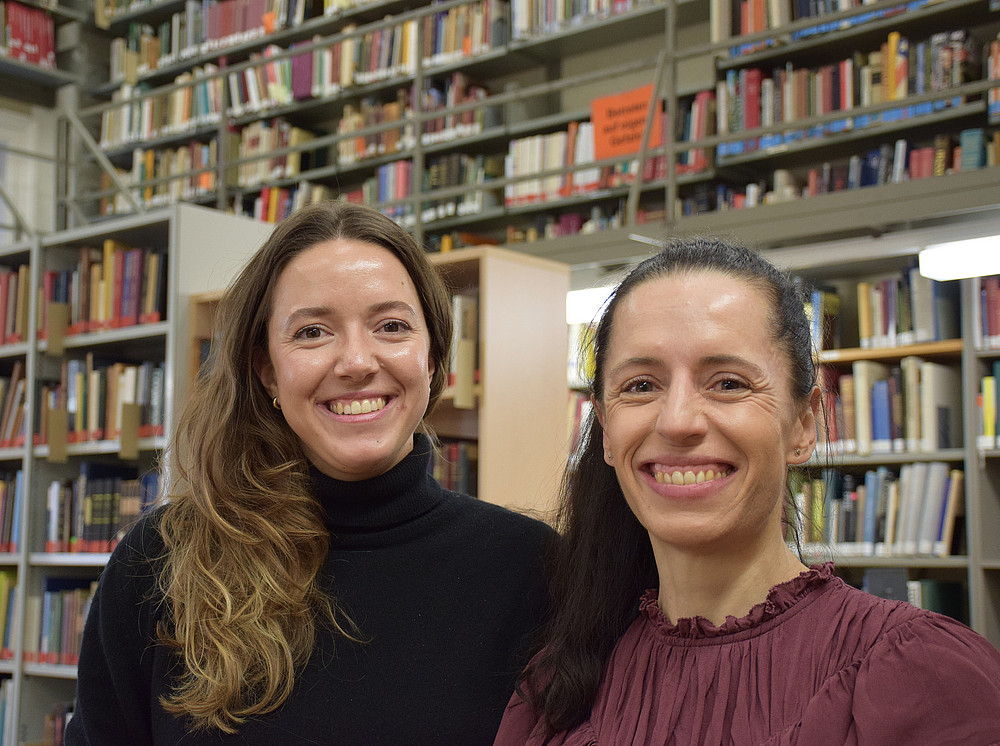Art and body
Evelyn Urban and Clara Nicolay not only share a passion for art history, but also a joint office at the Department of Arts and Musicology at the University of Graz. The two have been working on their dissertations as university assistants since autumn 2025, bringing a breath of fresh air to research and teaching. The daily exchange about their academic projects, the challenges of teaching and life as young researchers in Graz has become an inspiring routine for both of them.

Photographers
Evelyn Urban first studied education in Graz and then worked in the social sector. However, her enthusiasm for art history led her back to university, where she is currently working on her dissertation project "Faces of the Landscape: Erna Lendvai-Dircksen's Photographs of German Folk Faces in the Context of Race, Physiognomy and Landscape".
In her master's thesis "Eine Amerikanerin fotografiert das Kriegsende und nimmt ein Bad in Hitlers Wanne: Lee Millers Kriegsfotografien 1945", published by ART-Dok in Heidelberg in 2024, Evelyn Urban already dealt intensively with the significance of the context of visual language and the biography of the photographers.
In her dissertation project, Evelyn Urban examines the photographic work of Erna Lendvai-Dircksen during the Third Reich. Lendvai-Dircksen, known for her portrait and landscape photographs, supported the National Socialists' blood and soil theory with her images. Her photographs suggested, among other things, a connection between physiognomic features and landscape elements. In her research project, Evelyn Urban analyses the visual language and stylistic elements used in Lendvai-Dircksen's works. Urban critically analyses these in terms of both content and ideology. In particular, iconographic and formal aspects are focussed on in order to investigate possible (dis)continuities within her work. A central focus is on the question of how the identity of the people portrayed was constructed through the combination of physiognomic features and landscape elements.
The body as a medium
Clara Nicolays studied art history at the Goethe University Frankfurt a.M. and at the Università degli Studi "La Sapienza" in Rome. She is the founder of the Dok Netzwerk KGI Frankfurt, a platform for the exchange of young academics in the field of art history. She began her dissertation project with Hans Aurenhammer and Eva Struhal at Goethe University before transferring her research to the University of Graz.
In her dissertation "Zwischen Bühne und Leinwand. Theatrical events, artistic production and network formation in Florence around 1600", Clara Nicolay examines the connections between theatrical and artistic practice. At the centre of her research is the body as a medium of aesthetic experience. Based on this, Clara Nicolay addresses the question of how artists in Florence around 1600 integrated performative practices, such as taking part in theatre plays, into their artistic work. Many artists of this period were associated with academies or brotherhoods, of which there were many in Florence at this time and which also characterised the everyday lives of artists. Nicolay investigates the role of these networks and how they influenced artistic processes. To this end, she will also spend three months as an Eva Schler Fellow at the Medici Archive Project in Florence in 2026.
Evelyn Urban studied education, law and art history at the University of Graz. Since October 2025, she has been working as a university assistant in the field of 18th to 20th century art history with Julian Blunk.
Clara Nicolay studied art history and completed the advanced training programme "Book and Media Practice" at the Goethe University Frankfurt am Main. She has been a university assistant at the Department of Arts and Musicology since October 2025 and conducts research under the supervision of Robert Felfe.